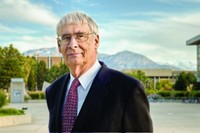Advertisement
Grab your lab coat. Let's get started
Welcome!
Welcome!
Create an account below to get 6 C&EN articles per month, receive newsletters and more - all free.
It seems this is your first time logging in online. Please enter the following information to continue.
As an ACS member you automatically get access to this site. All we need is few more details to create your reading experience.
Not you? Sign in with a different account.
Not you? Sign in with a different account.
ERROR 1
ERROR 1
ERROR 2
ERROR 2
ERROR 2
ERROR 2
ERROR 2
Password and Confirm password must match.
If you have an ACS member number, please enter it here so we can link this account to your membership. (optional)
ERROR 2
ACS values your privacy. By submitting your information, you are gaining access to C&EN and subscribing to our weekly newsletter. We use the information you provide to make your reading experience better, and we will never sell your data to third party members.
People
Arthur C. Cope Award: Eiichi Nakamura
Recipients are honored for contributions of major significance to chemistry
by A. Maureen Rouhi
February 22, 2010
| A version of this story appeared in
Volume 88, Issue 8
Eiichi Nakamura started a career based on synthetic methodology and total synthesis and has taken it far beyond the boundaries of traditionalchemistry. His accomplishments are vast, beginning in the 1980s with development of homoenolate chemistry and trimethylenemethane biradical chemistry, total synthesis of steroids, and mechanistic analysis of copper-catalyzed conjugate additions, among many others. The last area “has been characterized by controversy, misunderstanding, and myopic analysis over 20 years,” says Scott E. Denmark of the University of Illinois, Urbana-Champaign. “Nakamura’s theoretical studies provided the first unifying picture of mechanisms of organocopper reactions.”
By the 2000s, according to Iwao Ojima of the State University of New York, Stony Brook, Nakamura “started focusing on the boundaries of chemistry.” Here are just some of Nakamura’s contributions to biology, materials science, and single-molecule imaging: a new positron emission tomography probe based on oxygen-15 for glucose metabolism; fullerenes for DNA delivery; vesicles from fullerene anions, the only vesicles based on molecules unrelated to lipids; self-assembling nanoshuttlecock molecules; and direct observation of single molecules in motion.
Nakamura’s “picturesque representations of chemistry,” Ojima says, have contributed enormously “to the promotion of organic chemistry to researchers outside of chemistry.”
His “groundbreaking studies and applications of organometallic reactions and his imaginative excursions into the frontiers of materials” make him richly deserving of the Cope Scholar Award, Denmark says.
Nakamura, 58, is a professor of chemistry at the University of Tokyo and the research director of the Erato Nakamura Functional Carbon Clusters Project at the Japan Science & Technology Agency. He “distinguishes himself with his rare breadth in chemical sciences and his contributions to the expansion of new territories in organic chemistry,” Ojima says. He is “the single most influential scientist in his generation of Japanese organic chemists,” Denmark adds.
After receiving a Ph.D. from Tokyo Institute of Technology in 1978, Nakamura spent two years as a postdoctoral associate working with Gilbert Stork at Columbia University. He joined the institute in 1980 as an assistant professor and became professor in 1993. In 1995, he moved to the University of Tokyo.
His many honors include the “Shiju Hosho” or Medal of Honor with Purple Ribbon from the government of Japan in 2009. When he was inducted into the American Academy of Arts & Sciences as an honorary foreign member in chemistry in 2007, he became only the second Japanese to join the elite group of 32 foreign chemists, the first being Nobel Laureate Ryoji Noyori. In 2003, he became one of the youngest recipients of the Chemical Society of Japan Award, the highest award from the society. He is an elected fellow of the American Association for the Advancement of Science and of the Royal Society of Chemistry.
Nakamura’s service to the community includes stints as associate editor for Organic Letters, Accounts of Chemical Research, and other journals. Since April 2009, he has been serving as the first Asian associate editor of the Journal of the American Chemical Society. He is a member of the international organizing committee for Pacifichem 2010.




Join the conversation
Contact the reporter
Submit a Letter to the Editor for publication
Engage with us on Twitter